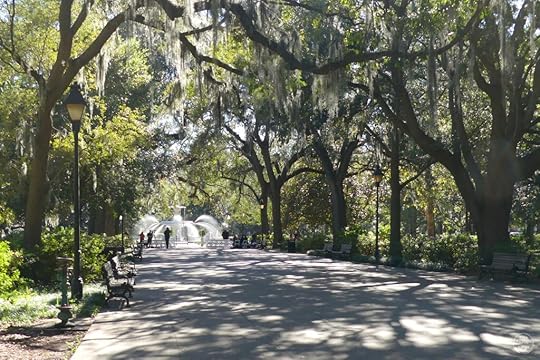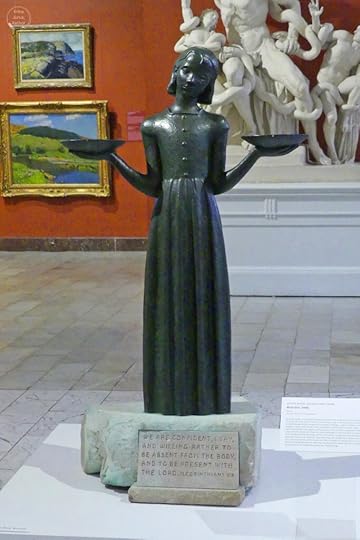Daytime in the Garden of Bad Tourists
Recently my hubby and I visited Savannah, Georgia, the setting for a best-selling phenomenon of a book, Midnight in the Garden of Good and Evil; it reigned at the top of the NY Times list for a still-unbroken record of 216 weeks. Didn’t read the book at the time, but we watched the movie, enjoyed it moderately.
Neither of us is a particular fan of true crime, so we weren’t on a quest to visit the locations of the murder story, other than to see the famous “Bird Girl” statue that has fascinated people ever since the reading public became aware of what would have remained a locally-famous shooting if it weren’t for John Berendt’s novel. It was my interest in the story of the statue that led me to researching and writing this post.
I write speculative fiction, i.e. I make a lot of things up. Certain historical figures and events enter my novels in a transmutated form, embellished by my imagination and thoughts about how events we know little about might have actually happened in the shadowy world of my urban fantasy. I hope that my versions make people pause, and think to themselves, Ooh, that’s an interesting idea!
Many locations in my novels are real, many not (or aren’t they?, I chuckle to myself as I try to blur the lines between reality and fantasy).
Lots of places, or pieces of places, have given me inspiration for their doppelgangers in the books. There is a real house, for example, that I based Wychwood manor on. When I was trying to come up with an atmospheric structure for the manor that forms such an important part of the story, I discarded ‘Victorian’ immediately – a little cliché. But I didn’t have a replacement in mind – until one autumn day when my hubby and I were doing a road trip in Ontario. We were driving through a small town that just happened to be on our route, and abruptly I said, “Stop!” (My hubby so loves it when I do that.)
On our right, perched on top of a bit of a hill, was a vintage house with a tower surmounting a wide veranda and portico, white with just the lightest pall of grey (at least on that overcast afternoon), and it subverted all the tropes about haunted houses. “Wychwood” was born.
I’ll never reveal where that house is. Should my books ever (fingers tightly crossed) become best sellers, I’d hate to think of the poor owners being overrun by fans only because their home suited my purpose perfectly. You can see a little of it on one of my series of bookmarks, but that’s as much as I’ll ever show of it.
On our road trip last month, we had only a day to spend in Savannah, but we enjoyed it. Savannah is a beguiling city, a lovely piece of time warp perched along the Savannah River, draped in Spanish moss and Southern gentility. We took a hop-on-hop-off tour – they’re extremely popular, and a good way to orient yourself – most of the way around, but eventually got off at the river to stretch our legs and have some lunch. The Boar’s Head Tavern, at the bottom of a curving downward street so chunky with old stones that the city advises against walking it for fear of injury, seemed like a good bet. Bouncing down in our tour bus was an adventure for our kidneys.
 Atmospheric bar in the Boar’s Head Tavern, Savannah GA – by E. Jurus, all rights reserved.
Atmospheric bar in the Boar’s Head Tavern, Savannah GA – by E. Jurus, all rights reserved.The Boar’s Head is in one of the older buildings in Savannah, a restored cotton warehouse built in the 1800’s. It shows – thick stone walls, heavy wooden beams overhead, and stone-framed windows that used to be doors opening to loading ramps. We were surprised that the tour guides didn’t recommend it – we had a superb meal in very atmospheric surroundings.
The Savannah River is still a well-used waterway for boats carrying shipping containers, riverboat cruises and other craft. There’s an nice market along the water with all manner of goodies.
What interested us most, though, were the big tree-shaded squares that define the historic district. Berendt mentioned them in his book, and it’s pretty much a given that you get out and explore them.
 1770 plan of Savannah showing the first six squares. The Savannah River and “north” are to the bottom of the image. In addition to the first four squares—Johnson, Wright, St. James (Telfair) and Ellis—this map also shows the later-constructed Reynolds and Oglethorpe Squares.
1770 plan of Savannah showing the first six squares. The Savannah River and “north” are to the bottom of the image. In addition to the first four squares—Johnson, Wright, St. James (Telfair) and Ellis—this map also shows the later-constructed Reynolds and Oglethorpe Squares.By Unknown author – Savannah, Public Domain, https://commons.wikimedia.org/w/index.php?curid=22743894
Lieutenant-General James Oglethorpe, a British Army officer, left a permanent legacy when he founded Savannah with a network of park squares around which beautiful residences were laid out. I don’t like sunlight much (my husband thinks I’m part vampire) and I loved the squares, offering plenty of dappled shade from trees dripping with moss. (I chuckle when Winifred Sanderson says, in Hocus Pocus, “Oh, look. Another glorious morning. Makes me sick!”) They’re also pockets of nature and green space right in the middle of the city. If we lived in the Historic District, I might find mornings more tolerable 
Each square is named after a different person, and has its own personality. A cobbled thoroughfare named Jones, lined with expensive and trendy homes, is the source of the ‘Keeping up with the Joneses’ saying. There’s a lot more history behind it all than that, but too much for today’s purpose.
 Elegant home on Jones St. in Savannah’s Historic District – by E. Jurus, all rights reserved
Elegant home on Jones St. in Savannah’s Historic District – by E. Jurus, all rights reservedThe tour buses maneuver carefully around the squares, astoundingly making the circuits without taking out the side panels of any of the parked cars. On our second leg, we disembarked at Forsyth Park, the big square with the fountain prominent in the movie. It was named for Georgia’s 33rd governor and spans 30 acres. The imposing fountain dates to 1858 and was modelled after the fountains at the Place de la Concorde in Paris. One avenue was blocked off for a beautifully-set wedding, with photographers, tripods and white chairs all set in place.
 Forsyth Park – by E. Jurus, all rights reserved
Forsyth Park – by E. Jurus, all rights reservedFrom there we strolled toward Monterey Square, where the now-infamous Mercer House, which became the glamorous home of antiques dealer Jim Williams in the late 1960s, stands sedately on one corner across from the park.
If you haven’t read the book or seen the movie, a local male prostitute named Danny Hansford, who was making the bed rounds of Savannah, both ‘high’ and ‘low’, was shot in Williams’ home. Williams’ story was that Danny, who was known to have a violent temper (especially when hopped up on booze and/or drugs), threatened him so badly one night that, in fear for his life, Williams shot him several times – including once in the back as Hansford lay dying on the antique carpet.
Williams was a ‘personality’ in Savannah society. A self-made millionaire, he bought the empty Mercer house, built for General Hugh Mercer, great-grandfather of famed songwriter Johnny Mercer (“Moon River”, “Days of Wine and Roses”…), restored it and turned it into the epicentre of the social scene with his exclusive and sought-after Christmas parties. He was a very active figure in the preservation of Savannah’s historic buildings, restoring over fifty of them.
 The Mercer/Williams house on Monterey Square – by E. Jurus, all rights reserved
The Mercer/Williams house on Monterey Square – by E. Jurus, all rights reservedOn May 2, 1981, Williams was arrested for the alleged murder of Hansford, whom he’d been intimate with. Williams’ sexuality was a fairly well-known ‘secret’ that everyone chose to ignore until it took titillating front and centre during the ensuing trials.
The first trial took place in 1982. It’s a little difficult to figure out the timeline – the movie fudged it considerably, for dramatic effect I imagine – but from what I can tell, writer Berendt only met Williams for the first time after that trial. Williams had already been convicted of murder, and had been released pending appeal.
Berendt moved to Savannah three years later, after Williams’s second conviction for the murder, and spent the next seven years researching the book. He attended the third and fourth trials. Williams was eventually acquitted at the fourth trial, but apparently confessed to Berendt after the third trial, which the author only put in the novel.
I haven’t read the entire book, in part because although the book is billed as non-fiction, both Berendt and Clint Eastwood, who directed the movie version, took so many peculiar liberties with the story. I wouldn’t be sure how much of what I was reading was factual.
For example, in the first chapter there’s a fictitious meeting with the author and Danny in Williams’ home. The rage-filled encounter actually happened and was recounted by Williams to Berendt. For some reason the author decided to make himself a part of it.
There’s a very dramatic scene in the movie where John Kelso (the fictionalized version of Berendt) had attended Williams’ Christmas party and is awakened in the middle of the night by the commotion of the police arriving to investigate the shooting. Kelso strolls through the murder scene and inadvertently appears in a crime scene photo that’s later introduced as evidence at the first trial. It’s such a bizarre addition to the tale.
I don’t read much true crime, and empathize with sifting through mountains of research to produce a book out of it all (writing imaginary fiction is so much easier), but there’s a distinct sense in Midnight in the Garden of Good and Evil that Berendt was drawn in by Williams’ saucy and irreverent personality, and perhaps wanted to be a part of his world to the extent of embedding himself in the story.
At any rate, the novel transformed sleepy Savannah into a tourism hot-spot – particularly the evocative photo on the front cover.
The statue was an actual sculpture, not just a cemetery decoration. It was created in 1936 by a renowned artist named Sylvia Shaw Judson. Fifty inches tall, it depicted a young girl with a contemplative expression holding up two bowls to contain food or water for birds. The model was an eight-year-old girl named Lorraine Greenman.
It was cast six times, five times in bronze and once in lead. One of the statues was bought by a Savannah family for their plot in Bonaventure Cemetery, with a pedestal inscribed “We are confident, I say, and willing rather to be absent from the body, and to be present with the Lord. II Corinthians 5:8“.
 The Bird Girl statue in the Telfair Museum – by E. Jurus, all rights reserved
The Bird Girl statue in the Telfair Museum – by E. Jurus, all rights reservedBonaventure is a huge cemetery along the Savannah River, located on the former site of Bonaventure Plantation. No one paid much attention to the statue among all the other decorative pieces until Random House publishers hired a local photographer, Jack Leigh, to produce an image for the cover of Berendt’s book. Leigh searched through the cemetery for something interesting, and found the statue on the Trosdal family plot. Tweaking the photo in the dark room, he gave it a moody feel that became the book’s iconic cover, and the statue seemed to be holding scales of justice that added to the aura.
Unsurprisingly, fans of the book began to flock to the cemetery to see the statue, until the family had it removed to keep so many visitors away from all their graves. They decided to lend the Bird Girl to the Telfair Museum, where it still resides. A fiberglass replica was made for use in the movie.
The book and movie have certainly been a big draw to Savannah. According to an article from 1996, The Book, as it became known, created a 46 percent increase in tourism, along with 24 new businesses and 1,500 new jobs. Thousands of copies and all kinds of other memorabilia have been sold.
There was another downside to the popularity of the Bird Girl statue, though. When we asked the staff at the Telfair Museum why the statue had been moved from the cemetery, we were expecting to hear things like people climbing on the statue, or perhaps trying to prop their kids up in the bowls for photo ops. But the reality was much worse: people were actually trying to break off pieces of the thing, I guess to put on a shelf at home to gather dust. That kind of behaviour is incomprehensible to my hubby and me – to vandalize a popular landmark.
To be honest, I’m not even sure that the statue we saw in the museum was the original – it wouldn’t surprise me at all if it was secretly a copy. Such an unfortunate outcome, surely not foreseen by the photographer or Random House.
It’s great to be an ardent fan of a story – I’m one myself, having made pilgrimages to both Hobbiton in New Zealand and the site where the Titanic was built in Belfast, Northern Ireland – but let’s all agree to appreciate these places respectfully, taking some photos to remember them by, and leaving them intact when we’re done, so that more fans are able to enjoy them after us.



